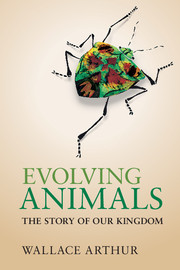Book contents
- Frontmatter
- Dedication
- Contents
- Preface
- Acknowledgements
- 1 What is an animal?
- 2 Before there were animals
- 3 How to make a fossil
- 4 The Cambrian explosion
- 5 How to make a species
- 6 Jellyfish and their kin
- 7 How to make a tree
- 8 The enigmatic urbilaterian
- 9 Animal symmetry and heads
- 10 A plethora of worms
- 11 Trends in animal complexity
- 12 Where the octopus is king
- 13 How to make an animal
- 14 Exoskeletons galore
- 15 Extinction
- 16 Mouth first, mouth second
- 17 Comparing embryos
- 18 Larvae, mouthparts and moulting
- 19 The animal toolkit
- 20 Vertebrate origins and evolution
- 21 From water to land to water
- 22 Variation and inheritance
- 23 Evolutionary novelties
- 24 Human origins and evolution
- 25 Animal plasticity
- 26 The nature of adaptation
- 27 The direction of evolution
- 28 Animal extremophiles
- 29 Extraterrestrial animals?
- 30 The ghost in the machine
- Appendix
- References
- Index
1 - What is an animal?
Published online by Cambridge University Press: 05 August 2014
- Frontmatter
- Dedication
- Contents
- Preface
- Acknowledgements
- 1 What is an animal?
- 2 Before there were animals
- 3 How to make a fossil
- 4 The Cambrian explosion
- 5 How to make a species
- 6 Jellyfish and their kin
- 7 How to make a tree
- 8 The enigmatic urbilaterian
- 9 Animal symmetry and heads
- 10 A plethora of worms
- 11 Trends in animal complexity
- 12 Where the octopus is king
- 13 How to make an animal
- 14 Exoskeletons galore
- 15 Extinction
- 16 Mouth first, mouth second
- 17 Comparing embryos
- 18 Larvae, mouthparts and moulting
- 19 The animal toolkit
- 20 Vertebrate origins and evolution
- 21 From water to land to water
- 22 Variation and inheritance
- 23 Evolutionary novelties
- 24 Human origins and evolution
- 25 Animal plasticity
- 26 The nature of adaptation
- 27 The direction of evolution
- 28 Animal extremophiles
- 29 Extraterrestrial animals?
- 30 The ghost in the machine
- Appendix
- References
- Index
Summary
What image first comes into your mind when you hear the word animal? A lion – ‘the king of the beasts’ – perhaps? Or, if you’re good at mental multitasking, maybe a whole array of different creatures? The reason why one or more images will immediately flash into existence is because we all think we know what an animal is. But do we? If so, do we also have an understanding of what the animal kingdom is? Over the years, I have tried to approach these questions by doing an experiment with students, as follows. In small-group tutorials, typically taking the form of five or six students and me sitting around a table for an hour or so, asking and answering questions, an opening question I often pose, since the students are specializing in zoology, is: can you give me an example of an animal?
The reaction to this question is usually one of bewilderment. It seems too simple: is it some sort of trick? After reassurance on my part that no trick is being played, and a little clarification that I just want a common name, not a Latin one, the answers flow fast. Here is what I usually get: tiger, dolphin, elephant, cow, wolf. Of course, I don’t mean that I usually get exactly those five names. So here is another example of the same kind of answer: leopard, giraffe, sheep, bat, whale.
- Type
- Chapter
- Information
- Evolving AnimalsThe Story of our Kingdom, pp. 1 - 12Publisher: Cambridge University PressPrint publication year: 2014



